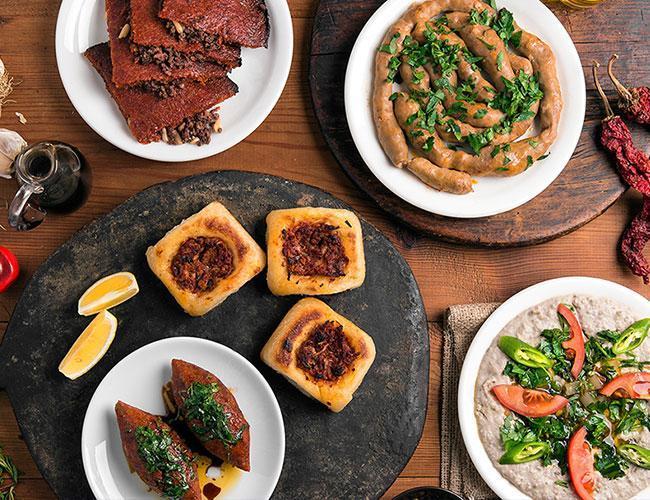
Turkey has three new entries in the UNESCO Creative Cities Network (UCCN): Istanbul as a city of design, Kütahya as a city of crafts and folk art, and finally Hatay (also known as Antioch) as a city of gastronomy.
Previously Gaziantep had led the way as Turkey’s first “city of gastronomy” in the UCCN.
When the new entries were announced at the Tourism Council 10 days ago in Ankara, some of the gastronomy council members were exhilarated by the news, not only for having another gastronomic city on the list but also for the inclusion of other themes that are closely related to gastronomy, such as design, crafts and folk art.
Naturally, the good news triggered a lot of discussions, with a lot of ideas put forward and comments made during the meetings. Kaya Demirer, the director of the Turkish Restaurant & Entertainment Association (TURYİD), said that Istanbul's new status as a design hub could also contribute to the gastronomy sector, with a mutual stimulation of creativity in both fields. Needless to say, Kütahya tiles are also closely related to gastronomy: the intricately drawn patterns and vivid colors of the Kütahya plates adorn Turkish banquets.
Another participant, Tayyar Zaimoğlu, a leading entrepreneur in the restaurant and hospitality sector from Adana, stressed the fact that Adana is almost a midway point between the two gastronomic cities. Though not in the network yet, the city is famous for its cuisine, and is widely considered the capital of kebab culture.
Some natives of the town that currently reside in Istanbul are known to fly over just to sate a lunch craving for their beloved kebabs.
Actually, it would be a shame not to make a route that links these three gastronomically significant cities, Hatay, Adana and Gaziantep, in order to create a sort of tasty triangle. Various other culinary destinations could be added to the route such as İskenderun, Mersin, Tarsus, and Kilis, which are all worth taking a detour for just to sample one of their delectable local specialties.
Each of these towns has more or less a similar cuisine, but each having their own special tastes. Creating such a culinary route with the collaboration of local authorities and civil society can help boost the national tourism, which is always more focused on eating and shopping. Cities can learn from each other’s best practices, join their forces and act collaboratively to turn the whole region as a culinary haven for international tourists.
With these thoughts bubbling in my mind, I attended to the fascinating talk on Aleppo, by historian Philip Mansel at the opening of the Levantine Heritage Foundation Conference. As inspiring as ever, listening to Mansel, I could not help think that actually the ultimate culinary capital of the region used to be Aleppo, once a fascinating city of diverse cultures. Both creative gastronomy cities of Gaziantep and Hatay used to be under the administration of the Vilayet (province) of Aleppo until only a century ago, cultural ties still strongly bond the cities together. Actually Gaziantep and Hatay have their connection through Aleppo rather than having a direct linkage.
Ideally, Aleppo should also be gastronomic creative city; the real tasty triangle was once Aleppo, Antioch (Hatay), and Antep (Gaziantep). Let’s hope that Aleppo will revive to its former glory; her sister cities are now hosting thousands of Aleppan refugees, hopefully they will be instrumental in creating further future bonds through food.
Recipe of the Week: This recipe is by renowned food writer Refika Birgül, combining tepsi kebabı literally round tray kebab of Hatay and sebzeli kebap, minced meat kebab with parsley and garlic of Gaziantep, combining two popular kebabs of both cities and creating a fusion cross culture taste. Have 400 gr medium fat beef, or preferably brisket, chopped finely by the butcher. Hand-chopped meat works better than minced meat in this recipe as the chunky meat remains juicier than machine-minced meat. Finely chop 2½ stalks of fresh spring garlic or mince 3 fat cloves garlic; chop 2-3 sprigs of fresh thyme, 2-3 stalks of fresh mint, and 10 stalks of parsley picking the leaves from the stalks first; finely chop a smallish capia pepper, add all to the meat. Season with about 1½ teaspoons salt, ½ teaspoon each of freshly milled black pepper and cumin, mix thoroughly and knead until the meat becomes a homogenous mass well worked with the herbs. Spread and press the meat mixture to a deep-dish pie or pizza tray or any metal or enamel round tray like a giant hamburger, push back the edges with a knife to make a neat shape. Dilute 1-heaped tablespoon of pepper paste with 3-4 tablespoons of water. Spread over the meat to cover evenly. Put quartered red onions around the edges and put a few green peppers seeded, and sliced lengthwise decoratively on the meat. Bake in pre-heated hot oven at 220 degrees for about 20-25 minutes.
Fork of the Week: Best humus in Turkey comes from Hatay, if visiting the town, try it at every restaurant you go to, but do not forget to look for Baklacı, Humusçu İbrahim.
For other local dishes, Sultan Sofrası is a must-visit. http://www.sultansofrasi.com/
Cork of the Week: Once again the wine selection comes from wine expert Mehmet Emin Türkat; when I asked about a pairing with the region’s grapes his advice was prompt and precise: From the Elazığ region, Kayra’s Alpagut project yields high quality, food friendly wine since the 2013 vintage, which will well go with this dish with its concentrated fruit, spicy complexity and lingering rich, almost savory finish. Another option would be Kuzeybağ, Öküzgözü wine again from Elazığ, with a slight touch of the indigenous Kösetevek grape in the blend, a local variety boosting up the structure; loads of fruit with spice and kernel notes that will support aromatic and savory kebab.